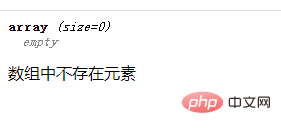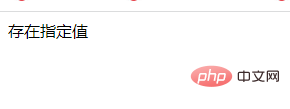How to check if an element exists in an array in php
Two methods to check whether there are elements in the array: 1. Use "===" to determine whether the array is "[]", the syntax is "array ===[]", if TRUE is returned, there is no element in the array There are elements, otherwise there are elements in the array; 2. Use count() or sizeof() to calculate the length of the array and determine whether the length of the array is 0. The syntax is "count(array)==0". If it is 0, there is no element in the array. There are elements, otherwise there are elements in the array.

The operating environment of this tutorial: windows7 system, PHP version 8.1, DELL G3 computer
php checks whether the array is Methods for existing elements
Check whether there are elements in the array, which is to check whether the array is an empty array (if it is an empty array, there are no elements in the array).
Method 1: Use "===" to determine whether the array is "[]"
If TRUE is returned, it is an empty array. Then there is no element in the array
If FALSE is returned, it is not an empty array, then there is an element in the array
<?php
header("content-type:text/html;charset=utf-8");
function f($arr){
// 检查数组是否为空
if($arr===[])
echo "数组中不存在元素";
else
echo "数组中存在元素";
}
$array = array();
var_dump($array);
f($array);
$array = array(1,2,3);
var_dump($array);
f($array);
?>
Method 2: Use count() or sizeof() function
An array with a length of 0 is called an "empty array". An empty array is a real object that only contains 0 elements.
Therefore, we can use the count() function to calculate the length of the array, and then determine whether the length is 0; if it is 0, it is an empty array, otherwise it is not an empty array.
count($arr,$m)
$m: is an optional parameter and can be omitted.
If the $m parameter is omitted, or set to COUNT_NORMAL or 0, the count() function will not detect multidimensional arrays;
If If $m is set to COUNT_RECURSIVE or 1, the count() function will recursively calculate the number of elements in the array, which is especially useful for calculating the number of elements in multi-dimensional arrays.
Example:
<?php
header("content-type:text/html;charset=utf-8");
function f($arr){
// 检查数组是否为空
if(count($arr))
echo "数组中存在元素";
else
echo "数组中不存在元素";
}
$array = array();
var_dump($array);
f($array);
$array = array(1,2,3);
var_dump($array);
f($array);
?>
## The sizeof() function is an alias of the count() function, that is The function and usage of the sizeof() function are exactly the same as the count() function.<?php header("content-type:text/html;charset=utf-8"); function f($arr){ // 检查数组是否为空 if(sizeof($arr)) echo "数组中存在元素"; else echo "数组中不存在元素"; } $array = array(); var_dump($array); f($array); ?>Copy after login

Extended knowledge: Check whether the specified element exists in the array
Method 1: Use the in_array() function
In PHP, if you want to query whether a certain value exists in an array, you can directly use the built-in function in_array()in_array() function to search the array Whether the specified value exists in . Returns TRUE if the value is found in the array, FALSE otherwise. Example:<?php
header('content-type:text/html;charset=utf-8');
$sites = array("Google", "phpcn", "Taobao", "Facebook");
if (in_array("phpcn", $sites)){
echo "存在指定值";
}
else{
echo "不存在指定值";
}
?>
Method 2: Use array_search() function
array_search() The function searches for a key value in the array and returns the corresponding key name. You can also use this function to query whether a certain value exists in the array. If it exists, the corresponding key name will be returned. If it does not exist, it will return false. Example:<?php
header('content-type:text/html;charset=utf-8');
$sites = array("Google", "phpcn", "Taobao", "Facebook");
if (array_search("red", $sites)){
echo "存在指定值";
}
else{
echo "不存在指定值";
}
?>PHP Video Tutorial"
The above is the detailed content of How to check if an element exists in an array in php. For more information, please follow other related articles on the PHP Chinese website!

Hot AI Tools

Undresser.AI Undress
AI-powered app for creating realistic nude photos

AI Clothes Remover
Online AI tool for removing clothes from photos.

Undress AI Tool
Undress images for free

Clothoff.io
AI clothes remover

Video Face Swap
Swap faces in any video effortlessly with our completely free AI face swap tool!

Hot Article

Hot Tools

Notepad++7.3.1
Easy-to-use and free code editor

SublimeText3 Chinese version
Chinese version, very easy to use

Zend Studio 13.0.1
Powerful PHP integrated development environment

Dreamweaver CS6
Visual web development tools

SublimeText3 Mac version
God-level code editing software (SublimeText3)

Hot Topics
 1667
1667
 14
14
 1426
1426
 52
52
 1328
1328
 25
25
 1273
1273
 29
29
 1255
1255
 24
24
 PHP: A Key Language for Web Development
Apr 13, 2025 am 12:08 AM
PHP: A Key Language for Web Development
Apr 13, 2025 am 12:08 AM
PHP is a scripting language widely used on the server side, especially suitable for web development. 1.PHP can embed HTML, process HTTP requests and responses, and supports a variety of databases. 2.PHP is used to generate dynamic web content, process form data, access databases, etc., with strong community support and open source resources. 3. PHP is an interpreted language, and the execution process includes lexical analysis, grammatical analysis, compilation and execution. 4.PHP can be combined with MySQL for advanced applications such as user registration systems. 5. When debugging PHP, you can use functions such as error_reporting() and var_dump(). 6. Optimize PHP code to use caching mechanisms, optimize database queries and use built-in functions. 7
 PHP and Python: Comparing Two Popular Programming Languages
Apr 14, 2025 am 12:13 AM
PHP and Python: Comparing Two Popular Programming Languages
Apr 14, 2025 am 12:13 AM
PHP and Python each have their own advantages, and choose according to project requirements. 1.PHP is suitable for web development, especially for rapid development and maintenance of websites. 2. Python is suitable for data science, machine learning and artificial intelligence, with concise syntax and suitable for beginners.
 PHP vs. Python: Understanding the Differences
Apr 11, 2025 am 12:15 AM
PHP vs. Python: Understanding the Differences
Apr 11, 2025 am 12:15 AM
PHP and Python each have their own advantages, and the choice should be based on project requirements. 1.PHP is suitable for web development, with simple syntax and high execution efficiency. 2. Python is suitable for data science and machine learning, with concise syntax and rich libraries.
 PHP in Action: Real-World Examples and Applications
Apr 14, 2025 am 12:19 AM
PHP in Action: Real-World Examples and Applications
Apr 14, 2025 am 12:19 AM
PHP is widely used in e-commerce, content management systems and API development. 1) E-commerce: used for shopping cart function and payment processing. 2) Content management system: used for dynamic content generation and user management. 3) API development: used for RESTful API development and API security. Through performance optimization and best practices, the efficiency and maintainability of PHP applications are improved.
 The Enduring Relevance of PHP: Is It Still Alive?
Apr 14, 2025 am 12:12 AM
The Enduring Relevance of PHP: Is It Still Alive?
Apr 14, 2025 am 12:12 AM
PHP is still dynamic and still occupies an important position in the field of modern programming. 1) PHP's simplicity and powerful community support make it widely used in web development; 2) Its flexibility and stability make it outstanding in handling web forms, database operations and file processing; 3) PHP is constantly evolving and optimizing, suitable for beginners and experienced developers.
 PHP and Python: Different Paradigms Explained
Apr 18, 2025 am 12:26 AM
PHP and Python: Different Paradigms Explained
Apr 18, 2025 am 12:26 AM
PHP is mainly procedural programming, but also supports object-oriented programming (OOP); Python supports a variety of paradigms, including OOP, functional and procedural programming. PHP is suitable for web development, and Python is suitable for a variety of applications such as data analysis and machine learning.
 PHP vs. Other Languages: A Comparison
Apr 13, 2025 am 12:19 AM
PHP vs. Other Languages: A Comparison
Apr 13, 2025 am 12:19 AM
PHP is suitable for web development, especially in rapid development and processing dynamic content, but is not good at data science and enterprise-level applications. Compared with Python, PHP has more advantages in web development, but is not as good as Python in the field of data science; compared with Java, PHP performs worse in enterprise-level applications, but is more flexible in web development; compared with JavaScript, PHP is more concise in back-end development, but is not as good as JavaScript in front-end development.
 PHP and Python: Code Examples and Comparison
Apr 15, 2025 am 12:07 AM
PHP and Python: Code Examples and Comparison
Apr 15, 2025 am 12:07 AM
PHP and Python have their own advantages and disadvantages, and the choice depends on project needs and personal preferences. 1.PHP is suitable for rapid development and maintenance of large-scale web applications. 2. Python dominates the field of data science and machine learning.





